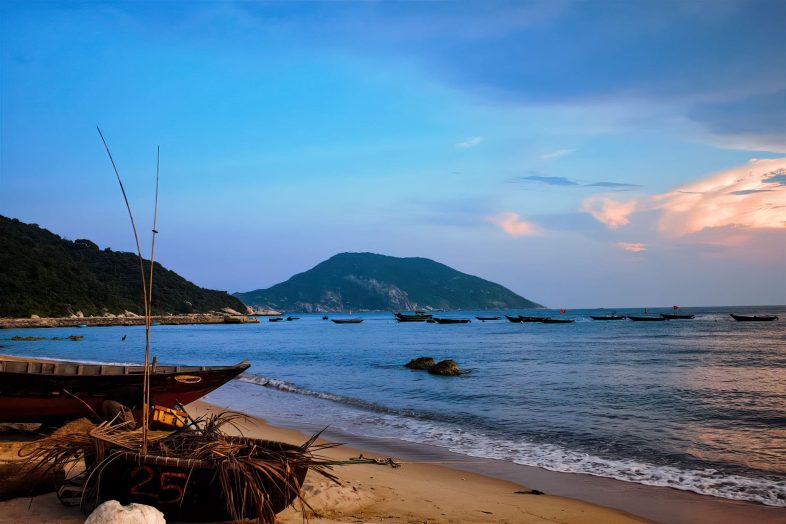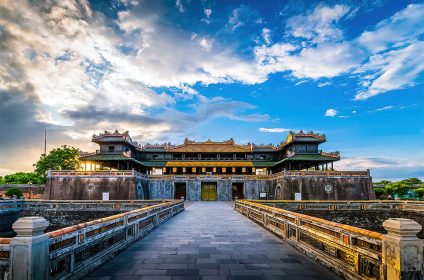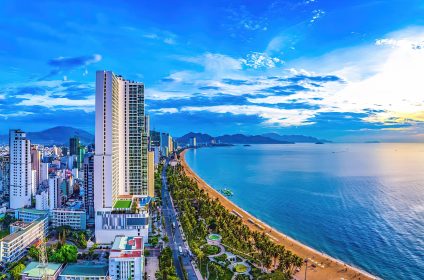
Cham Island
Cham Island (also Cu Lao Cham, Hon Lao) is the largest of the Cham Islands and is located 16 kilometers off the coast of Hoi An. It has an area of 15km2 and is home to 3,000 people, the most of whom live in the vicinity of the main harbour. It has a lengthy coastline with sandy beaches on one side and rock cliffs with bird nest caves on the other. Many unusual animals are alive under the canopy of virtually primitive woods from the coast to the tops of mountains. Visitors can tour about and enjoy breathtaking views thanks to newly constructed contour roads. Cham Island’s underwater habitat is one of the most diverse in the country. During the summer, around 2,500 visitors come to discover the beautiful coral reefs and diverse animals. Interestingly, without wood ash from here, Hoi An’s distinctive noodle dish Cao lau cannot be real.
The Cham Islands comprises 8 islands and each has its unique differences. Hon Lao (the largest), Hon Tai (Ear island), Hon La (Leaf island), Hon Kho Me (Dry island “the mother”), Hon Kho Con (Dry island “the children”), Hon Mo (Tomb island), Hon Ong (Tomb island) are the others (Grandfather island).
The occupation of the people of the islands is largely fishing.
The ancient scenery of the Cu Lao Cham Islands includes various sand beaches, forested hills, and the sea. Camping, swimming, and scuba diving are all available. Corals and marine life are popular in these island waters.
The UNESCO Biosphere Reserve Cu Lao Cham – Hoi An was established in May 2009. It encompasses Hoi An Old Town, most of urban Hoi An, the river inlet, the ocean between Hoi An and the Cham Islands, and the islands.
However, since the establishment of this UNESCO Biosphere Reserve, domestic mass tourism has resulted in growing devastation of the islands, their populations, and the ecosystem.
The UNESCO Biosphere Reserve designation is intended to assure preservation and, as a result, an increase in environmental sustainability. As soon as UNESCO status was granted in 2009, mass tourism erupted, resulting in the islands being fished out in summer 2010 due to the large increase of visitors. In 2011 the situation got worse.
The “birds nest” industry in CLC is one of the most visible examples of damage within a UNESCO Biosphere Reserve. This company does not employ a single local islander. The figures are staggering: a kilogram of bird nests sells for roughly US$4,000. All this is happening inside a United Nations sanctioned location.

Cham Islands - Info
Elevation
Population
Area
Time zone
Cham Islands Travel Guide
Best time to visit Cham Islands
The dry season, which lasts from February until the end of August, is the ideal time to explore Cham Island. Typhoons and heavy rains are the bare minimum during these months that make it possible to plan outside activities and transportation securely.
There is a lot of sunshine, a bright sky, and pleasant waters there. All are great places to see historical structures, enjoy the beach, take pictures, and begin underwater explorations. Bring sunscreen, sunglasses, a swimsuit, a phone case, and cash when you visit.
Additionally, the freshest and widest variety of seafoods are caught and are ready for consumption. Some seashore hamlets (like Bai Huong) are ideal if you want to stay somewhere quiet and away from busy cities.
How To Travel To Cham Islands
From Hanoi and Ho Chi Minh City, visitors can go to Hoi An city, where they can either ride a ferry at the public port there at 7.30 am or sign up for a guided tour through one of the city’s tourism businesses.
In Hoi An, there are no airports. As a result, the only method to go by air to Hoi An is to land at Da Nang International Airport, from whence you may either take a public bus to Hoi An for just 10,000 VND or a cab for roughly 600,000 VND. The public bus from Da Nang for Hoi An is difficult to find, though.
The closest train station is in the city of Da Nang, and the train does not stop at Hoi An either. This also implies that the only ways to go to Hoi An are by bus or taxi.
Activities & Things to do on Cham Islands
On a day excursion to Cham Island, no tourist would want to miss this amazing underwater sport. It is included in guided excursions and easy to reserve for independent travelers.
The offshore waters of Cham Island have one of the most diverse marine ecosystems in Vietnam. To explore more (and better) snorkeling places, vacationers must pay extra or arrange a snorkeling-specific tour. The second option is offered on a daily or multiple-day basis.
Numerous tourists prefer snorkeling to scuba diving on day trips to Cham Island because it requires less skills and is less expensive. Almost always, scuba diving gear and equipment are accessible on the boat, although an announcement (booking) must be made beforehand.
Food & Restaurants on Cham Islands
Travelers can sample some of Cham Island’s numerous delectable specialities while there.
Cellana (also known as the “woman chest snail” or “oc vu vang”), banh it la gai (a ramie cake with a coconut filling), and woodland veggies are all featured in seaside restaurants’ set-menu lunches.
On iron nets, local ladies can be seen creating muc mot nang (partially dried squids) when strolling along the harbor.
At Bai Ong, Bai Lang, and Bai Chong, three beaches frequented by tourists, visitors can find restaurants and eateries.
Bai Ong and Bai Chong are frequented by day-tourists, and thus, many locations are only available during the day.
Stay Safe & Healthy in Cham Islands
Breaking swells from September through December (during the NE monsoon season) make Cham Islands almost inaccessible; from January to April only occasionally accessible; and from May to August almost always accessible.
This is due to the extremely shallow water conditions at the river inlet to the ocean, which has an average depth of only 900 mm.
The weather also changes during the day; it is quieter in the mornings, but winds and waves pick up around noon.
Squalls frequently occur in the late afternoons during the summer, especially later in the season in August (look towards Laos and see if dark clouds are forming).



